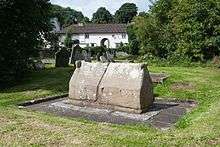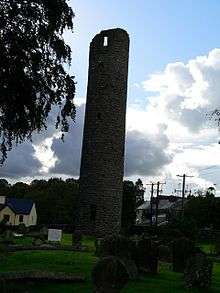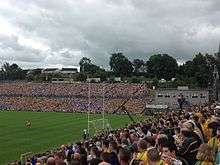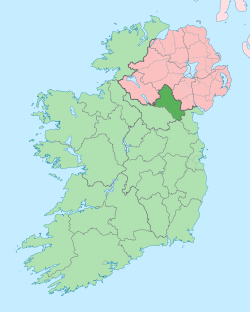Clones, County Monaghan
Clones (/ˈkloʊnɪs/ KLOH-nis; from Irish: Cluain Eois[7]) is a small town in western County Monaghan, Ireland. The area is part of the Border Region, earmarked for economic development by the Irish Government due to its currently below-average economic situation. The town was badly hit economically by the partition of Ireland in 1921 because of its location on the border with County Fermanagh in Northern Ireland. The creation of the Irish border deprived it of access to a large part of its economic hinterland for many years. The town had a population of 1,680 at the 2016 census.[1]
Clones Cluain Eois | |
|---|---|
Town | |
 | |
 Clones Location in Ireland | |
| Coordinates: 54.183°N 7.2337°W | |
| Country | Ireland |
| Province | Ulster |
| County | County Monaghan |
| Elevation | 71 m (233 ft) |
| Population (2016)[1] | |
| • Total | 1,680 |
| Eircode routing key | H23 |
| Telephone area code | +353(0)47 |
| Irish Grid Reference | H500257 |
| Website | www |
| Historical population | ||
|---|---|---|
| Year | Pop. | ±% |
| 1821 | 2,240 | — |
| 1831 | 2,381 | +6.3% |
| 1841 | 2,877 | +20.8% |
| 1851 | 2,319 | −19.4% |
| 1861 | 2,390 | +3.1% |
| 1871 | 2,170 | −9.2% |
| 1881 | 2,216 | +2.1% |
| 1891 | 2,032 | −8.3% |
| 1901 | 2,068 | +1.8% |
| 1911 | 2,401 | +16.1% |
| 1926 | 2,365 | −1.5% |
| 1936 | 2,235 | −5.5% |
| 1946 | 2,092 | −6.4% |
| 1951 | 2,455 | +17.4% |
| 1956 | 2,399 | −2.3% |
| 1961 | 2,107 | −12.2% |
| 1966 | 2,038 | −3.3% |
| 1971 | 2,164 | +6.2% |
| 1981 | 2,556 | +18.1% |
| 1986 | 2,542 | −0.5% |
| 1991 | 2,347 | −7.7% |
| 1996 | 2,170 | −7.5% |
| 2002 | 1,947 | −10.3% |
| 2006 | 1,767 | −9.2% |
| 2011 | 1,761 | −0.3% |
| 2016 | 1,680 | −4.6% |
| [1][2][3][4][5][6] | ||
Name
Historically Clones was also spelt Clonis, Clonish and Clownish. These are anglicised versions of the Irish Cluain Eois, meaning "Eos's meadow". The ancient name was Cluan Innis, "island of retreat", it having formerly been nearly surrounded by water.[7]
History


Clones was the site of a monastic settlement in the kingdom of Dartraige Con-innsi, founded by Tigernach (anglicised Tierney) in the 6th century, until the dissolution of the monasteries by Henry VIII. St. Tigernach or Tierney's abbey, built in the early 6th century was dedicated to St. Peter and St. Paul. Tigernach later became Bishop of Clogher and removed that see to Clones, where he died of the plague in 550. The abbot was the Primus Abbas, or first mitred abbot of Ireland. The ruins of a 12th century abbey building can still be found in the town, along with a sarcophagus reputed to have been built to house the remains of Saint Tighearnach, and a 9th century round tower and high cross. In 2016, a forgotten 17th Century plantation castle was discovered behind an area walled off to prevent accidental falls from a steep drumlin. The site was purchased by Fáilte, a support group for prisoners, which is arranging further archaeological work.[8]
In February 1922, just after the partition of Ireland, Clones was the scene of a confrontation between the Ulster Special Constabulary and the Irish Republican Army. The Special Constabulary were a temporary, armed police force raised in Northern Ireland to put down IRA guerrillas there. Since the end of the Irish War of Independence in July 1921, the IRA were acting as the de facto army of the Provisional Government of the Irish Free State. A unit of Special Constabulary was travelling by train to Belfast, but was stopped by an IRA unit at Clones while they were changing trains. The IRA men demanded that they surrender and a gun battle broke out. An IRA officer was killed, as were four Special Constables. Nine other USC men were injured and the rest surrendered. The incident, known as the 'Clones Affray' at the time, threatened to cause the collapse of the Anglo-Irish Treaty and prompted the British government to suspend the withdrawal of British troops from the Free State.
During The Troubles on 28 December 1972 on the same day as the Belturbet bombing in County Cavan which killed two teenagers and injured several other people a car bomb, which was in a blue Morris 1100 car on Fermanagh Street in Clones exploded at 10:01 pm, which seriously injured two men. The bombings are believed to be the work of the terrorist organization the Ulster Volunteer Force (UVF).[9][10]
Railways
Clones was linked by rail to Dundalk from 1855, Enniskillen from 1859, Cavan from 1862 and Armagh from 1863.[11] Clones railway station was opened on 26 June 1858[12] by the Dundalk and Enniskillen Railway. From 1876 all of these lines were part of the Great Northern Railway.
The partition of Ireland in 1922 made Clones a border post on the railway, which combined with road competition to cause the Great Northern to decline. In 1954 the governments of the Republic and Northern Ireland jointly nationalised the GNR and in 1957 Northern Ireland made the GNR close its lines from Armagh and Enniskillen to Clones.[13] This made it impractical to continue services on the Cavan and Dundalk lines so the GNR withdrew passenger services on those lines as well, leaving Clones with no passenger trains and a freight service truncated at the border.[13] The GNR closed Clones station to passenger traffic on 14 October 1957.[12]
In 1958 the two states partitioned the GNR between the Ulster Transport Authority and CIÉ. CIÉ withdrew freight services from the Cavan line in 1959 and from the Dundalk line in 1960, leaving Clones with no railway at all.[13] CIÉ closed Clones freight depot on 1 January 1960.[12]
Ulster Canal restoration
The national inland waterways agency, Waterways Ireland, is planning to restore the Ulster Canal from the Newtownbutler area of Lough Erne to Clones.
Sport

Clones is now mainly known in Ireland as being the location of the GAA stadium, St Tiernach's Park also the home of Monaghan GAA. This stadium is regularly used for inter-county matches during the Ulster provincial championship in Gaelic football, and traditionally hosts the final. The summer football season was therefore a major source of revenue for businesses in the town.

The PEACE Link Clones is a sporting facility on the edge of Clones.[14] Its facilities include a 400m running track, in-field grass pitch, a 3G multi-purpose playing pitch, an indoor sports centre, changing facilities, and a gym.
A greyhound racing track operated from 1935 until 1962.[15] The track was opened by the Clones Greyhound Racing Company Limited and raced under the Irish Coursing Club Rules up until November 1939 and later unlicensed until 1962.[16] William Mealiff was a founding member of the company and the track was on the land near Bishopscourt.[17] The pitch inside the track hosted a Clones rugby team that was formed in 1935.
Festivals
Clones Film Festival
Clones Film Festival was launched in 2002 and takes place on the October Bank Holiday weekend.
Flat Lake Festival
The Flat Lake Festival is an annual event hosted by Kevin Allen in Hilton Park, Clones. Since its inception in 2007, it has hosted readings, comedy, music and theatre events within a farm estate. It is held in the Hilton Park over the period of a long weekend, a few miles outside the town of Clones on the back road to Cavan town. In previous years it has taken place in mid-August.
Notable people
- Barry McGuigan, world featherweight champion boxer known as 'The Clones Cyclone', was born here
- John George Bowes, Mayor of Toronto (1851–1853), was born in Clones
- Roger Boyle, bishop, is buried in Clones churchyard
- Thomas Bracken, poet who wrote "God Defend New Zealand", one of the national anthems of New Zealand, is from Clones
- Jonathan Douglas, footballer who grew up in Clones.[18]
- Joseph Finegan, General who commanded the Confederate Army at the 1864 Battle of Olustee during the American Civil War, was born at Clones in 1814.
- James Graham, an Irish non-commissioned officer in the British Army during the Napoleonic Wars, reputed to be the "bravest man in the army".
- John Joseph Lynch (1816–1888), first Archbishop of Toronto (1860–1888), was born here
- Kevin McBride, boxer, is from Clones
- Patrick McCabe, novelist and author of The Butcher Boy which is set in a thinly-disguised version of Clones. Parts of Neil Jordan's 1997 film adaptation of the book were filmed in the town. McCabe is honorary patron of the Clones Film Festival.
- Eugene McCabe, writer and playwright, comes from the town and is known for his novels such as Death and Nightingales
- James Cecil Parke, sportsman who as 1912 Australasian Championships singles and doubles champion, 1914 Australasian Championships mixed doubles champion, 1912 Davis Cup winner, 1908 Summer Olympics silver medalist in tennis, and Leinster and Irish rugby union player
- Alexander Pearce, a notorious cannibal convict who was executed in Van Diemen's Land in 1824, was from Clones
Climate
Climate in this area has mild differences between highs and lows, and there is adequate rainfall year-round. The Köppen Climate Classification subtype for this climate is "Cfb" (Marine West Coast Climate/Oceanic climate).[19]
| Climate data for Clones (1978–2007, extremes 1951–2008) | |||||||||||||
|---|---|---|---|---|---|---|---|---|---|---|---|---|---|
| Month | Jan | Feb | Mar | Apr | May | Jun | Jul | Aug | Sep | Oct | Nov | Dec | Year |
| Record high °C (°F) | 14.8 (58.6) |
16.3 (61.3) |
20.6 (69.1) |
21.9 (71.4) |
25.9 (78.6) |
29.3 (84.7) |
30.5 (86.9) |
28.8 (83.8) |
25.4 (77.7) |
22.1 (71.8) |
16.9 (62.4) |
14.8 (58.6) |
30.5 (86.9) |
| Average high °C (°F) | 7.2 (45.0) |
7.8 (46.0) |
9.7 (49.5) |
12.1 (53.8) |
15.1 (59.2) |
17.4 (63.3) |
19.2 (66.6) |
18.8 (65.8) |
16.6 (61.9) |
13.1 (55.6) |
9.8 (49.6) |
7.6 (45.7) |
12.9 (55.2) |
| Daily mean °C (°F) | 4.4 (39.9) |
4.7 (40.5) |
6.4 (43.5) |
8.1 (46.6) |
10.8 (51.4) |
13.4 (56.1) |
15.3 (59.5) |
15.0 (59.0) |
12.9 (55.2) |
9.9 (49.8) |
6.8 (44.2) |
5.0 (41.0) |
9.4 (48.9) |
| Average low °C (°F) | 1.6 (34.9) |
1.6 (34.9) |
3.0 (37.4) |
4.2 (39.6) |
6.5 (43.7) |
9.5 (49.1) |
11.4 (52.5) |
11.1 (52.0) |
9.2 (48.6) |
6.6 (43.9) |
3.9 (39.0) |
2.3 (36.1) |
5.9 (42.6) |
| Record low °C (°F) | −12.4 (9.7) |
−9.9 (14.2) |
−9.8 (14.4) |
−4.2 (24.4) |
−3.7 (25.3) |
0.5 (32.9) |
4.1 (39.4) |
1.5 (34.7) |
−0.9 (30.4) |
−4.5 (23.9) |
−8.1 (17.4) |
−11.0 (12.2) |
−12.4 (9.7) |
| Average precipitation mm (inches) | 87.6 (3.45) |
71.0 (2.80) |
84.0 (3.31) |
61.6 (2.43) |
63.4 (2.50) |
70.9 (2.79) |
70.8 (2.79) |
88.7 (3.49) |
76.2 (3.00) |
102.7 (4.04) |
85.1 (3.35) |
98.4 (3.87) |
960.4 (37.81) |
| Average precipitation days (≥ 0.2 mm) | 20 | 17 | 20 | 16 | 16 | 17 | 18 | 18 | 18 | 20 | 19 | 19 | 218 |
| Average snowy days | 4.9 | 4.7 | 3.8 | 1.1 | 0.3 | 0.0 | 0.0 | 0.0 | 0.0 | 0.0 | 0.6 | 2.6 | 18.0 |
| Average relative humidity (%) (at 15:00 LST) | 83.3 | 77.3 | 72.9 | 67.5 | 66.5 | 68.7 | 69.6 | 71.2 | 72.8 | 77.3 | 82.5 | 85.9 | 74.6 |
| Mean monthly sunshine hours | 46.5 | 62.2 | 93.0 | 138.0 | 173.6 | 138.0 | 136.4 | 130.2 | 108.0 | 86.8 | 54.0 | 37.2 | 1,203.9 |
| Mean daily sunshine hours | 1.5 | 2.2 | 3.0 | 4.6 | 5.6 | 4.6 | 4.4 | 4.2 | 3.6 | 2.8 | 1.8 | 1.2 | 3.3 |
| Source: Met Éireann[20][21][22] | |||||||||||||
Annalistic references
See Annals of Inisfallen (AI).
- AI806.1 Kl. Gormgal son of Dindathach, abbot of Ard Macna and Cluain Eóis, rested.
See also
- List of towns and villages in the Republic of Ireland
- Market Houses in the Republic of Ireland
- Midland Railway Action Group
- Clones, County Fermanagh
References
- "Census 2016 Sapmap Area: Settlements Clones". Central Statistics Office (Ireland). Retrieved 26 June 2019.
- Census for post 1821 figures. Cso.ie. Retrieved on 10 July 2012.
- histpop.org Archived 7 May 2016 at the Wayback Machine
- NISRA – Northern Ireland Statistics and Research Agency Archived 17 February 2012 at the Wayback Machine. Nisranew.nisra.gov.uk. Retrieved on 10 July 2012.
- Lee, JJ (1981). "On the accuracy of the Pre-famine Irish censuses". In Goldstrom, J. M.; Clarkson, L. A. (eds.). Irish Population, Economy, and Society: Essays in Honour of the Late K. H. Connell. Oxford, England: Clarendon Press.
- Mokyr, Joel; O Grada, Cormac (1984). "New Developments in Irish Population History, 1700–1850". The Economic History Review. 37 (4): 473–488. doi:10.1111/j.1468-0289.1984.tb00344.x. hdl:10197/1406.
- "Cluain Eois/Clones". Placenames Database of Ireland. Government of Ireland - Department of Arts, Heritage and the Gaeltacht and Dublin City University. Retrieved 26 June 2019.
- Linehan, Hugh (20 August 2016). century-plantation-castle-found-hiding-in-plain-sight-1.2762110 "17th-century plantation castle found hiding in plain sight" Check
|url=value (help). Irish Times. Irish Times. Retrieved 26 August 2016. - "Justice For The Forgotten". www.dublinmonaghanbombings.org. Retrieved 12 April 2018.
- Melaugh, Dr Martin. "CAIN: Chronology of the Conflict 1972". cain.ulst.ac.uk. Retrieved 12 April 2018.
- Hajducki, S. Maxwell (1974). A Railway Atlas of Ireland. Newton Abbott: David & Charles. map 14. ISBN 978-0-7153-5167-3.
- "Clones station" (PDF). Railscot – Irish Railways. Retrieved 17 September 2007.
- Hajducki, S. Maxwell (1974). A Railway Atlas of Ireland. Newton Abbott: David & Charles. map 39. ISBN 978-0-7153-5167-3.
- https://www.thepeacelink.eu/
- Barnes, Julia (1988). Daily Mirror Greyhound Fact File, page 413. Ringpress Books. ISBN 0-948955-15-5.
- "Clones Greyhound Racing Company - 11 September 1950". Irish Independent. 1950.
- "The Mealiff Family". Turtle Bunbury.
- "Football: Douglas is Clones cyclone. - Free Online Library". www.thefreelibrary.com. Retrieved 12 April 2018.
- "Clones, Ireland Köppen Climate Classification (Weatherbase)". Weatherbase. Retrieved 12 April 2018.
- "Clones 1981–2010 averages". Met Éireann. Retrieved 27 May 2015.
- "Absolute Maximum Air Temperatures for each Month at Selected Stations" (PDF). Met Éireann. Archived from the original (PDF) on 4 March 2016. Retrieved 27 May 2015.
- "Absolute Minimum Air Temperatures for each Month at Selected Stations" (PDF). Met Éireann. Archived from the original (PDF) on 29 January 2017. Retrieved 27 May 2015.
External links
| Wikimedia Commons has media related to Clones, County Monaghan. |
